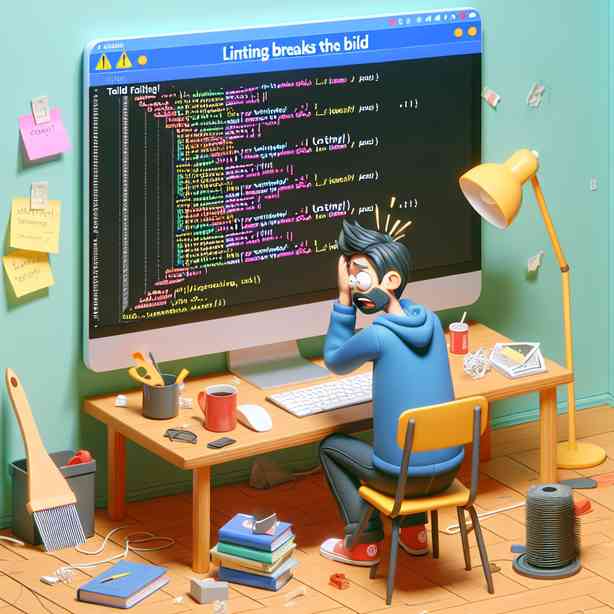
Linting is often an overlooked aspect of the software development process, but it can dramatically impact code quality and maintainability. The situation where linting breaks the build is not uncommon, especially when teams rely on stringent linting rules to ensure code consistency and quality. This article delves into the nuances of linting in software development, examining its importance, common pitfalls, and strategies to mitigate issues when linting fails, thus preventing those frustrating moments when your build breaks unexpectedly.
Linting tools operate by analyzing source code for stylistic and programming errors. They help ensure that code adheres to predefined coding standards, such as naming conventions, indentation styles, and best practices for writing clean and efficient code. By integrating linting into the development workflow, teams can catch potential issues early and promote a culture of code quality from the outset. This systematic approach can lead to reduced bugs, enhanced readability, and increased efficiency in the long run. However, while linting is beneficial, it also poses a risk if not managed correctly, particularly when it directly influences the integrity of the build process.
When linting rules are too strict or improperly configured, they can lead to situations where even minor stylistic issues lead to a broken build. For example, if a project employs a linter that enforces specific whitespace rules or prohibits the use of console logging, a single unaddressed error can cascade through the build pipeline. This can not only halt progress but also frustrate developers who may not fully understand the reasons behind the failure. In this context, it’s crucial to strike a balance between enforcing standards and allowing flexibility that accommodates developers’ workflows.
Communication within the development team plays a vital role in mitigating these frustrations. It’s essential to establish a shared understanding among team members regarding the purpose of linting and the specific rules that have been put in place. Holding workshops or discussions to clarify the rationale behind certain linting rules can facilitate a more collaborative environment. When developers perceive linting as a supportive tool rather than an obstacle, they are more likely to embrace its principles, easing tension within the team when build errors occur due to linting issues.
Another strategy to reduce the likelihood of linting breaking the build is to configure linting and CI/CD processes thoughtfully. Continuous Integration and Continuous Deployment set the stage for automatic linting, but it’s crucial to ensure that the linting configurations are suitable for the project. Setting up a pre-commit hook to run linting checks can catch linting errors before they even reach the build stage, providing immediate feedback to developers. This proactive approach not only addresses potential issues earlier but also fosters a culture of responsibility among the developers, as they are encouraged to maintain their code quality before it reaches the wider project.
Moreover, teams might consider adopting linting rules based on the maturity of their codebase and development practices. New projects may benefit from more stringent rules as they establish their coding foundation, whereas mature codebases might fare better with more lenient guidelines. Tailoring linting configurations in alignment with the evolving nature of the project and team workflow ensures that the build process remains smooth and productive, preventing unnecessary breakdowns caused by overly rigid standards.
Adopting a gradual approach to integrating new linting rules is also advantageous. Instead of implementing a comprehensive set of rules all at once, introducing rules incrementally allows developers to adjust and adapt without feeling overwhelmed. This phased approach mitigates the risk of breaking the build and provides ample opportunity for developers to familiarize themselves with the new standards, ultimately leading to a more cohesive codebase.
In some cases, it might be appropriate to incorporate exceptions or overrides for specific files or directories within a project. Recognizing that certain code may require different styling or rules can prevent linting from becoming a rigid bottleneck that restricts innovative solutions. Such flexibility ensures that developers are empowered to make decisions about the most suitable coding practices for their tasks while still adhering to a general code quality framework.
While it is essential to emphasize the importance of linting, it is equally important to remember that it is not a substitute for thorough manual code reviews. Linting can catch a myriad of issues, but it cannot replace the nuanced understanding that comes from human oversight. Complementing linting with peer reviews creates a multi-faceted approach to code quality, blending automated checks with insightful feedback from fellow developers. This combined strategy not only fortifies the code against errors but also cultivates a learning environment that can enhance the overall skill level within the team.
Ultimately, addressing the underlying issues that lead to linting breaking the build requires a comprehensive approach that encompasses team culture, configuration practices, and strategic onboarding of linting rules. By fostering open communication, leveraging proactive tools and processes, and considering the unique context of your team’s coding practices, it is possible to minimize disruptions caused by linting errors. Ensuring a healthy balance between enforcing linting rules and allowing reasonable flexibility will not only streamline the development process but will also contribute to higher quality code and greater team satisfaction.
In conclusion, while moments when linting breaks the build can be frustrating, they also present opportunities for growth and development within a team. By addressing these challenges through effective communication, thoughtful configurations, and a progressive onboarding approach to linting rules, teams can navigate these obstacles while maintaining an unwavering focus on code quality. Remember that the end goal is to produce maintainable, high-quality code while fostering an environment where developers feel supported and empowered to contribute to the project’s success. Through continuous learning and adaptation, linting can evolve into a powerful ally in the quest for excellence in software development.


